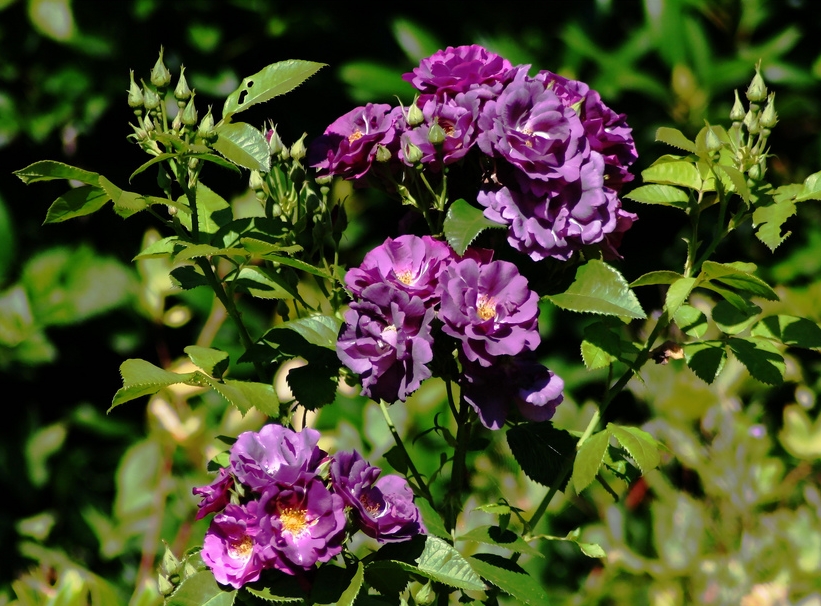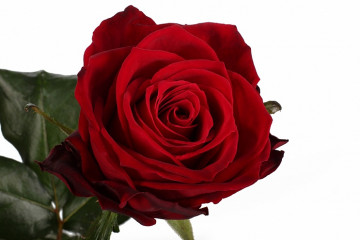Rose Rhapsody in Blue - description of the shraba variety
Content:
Rosa Rhapsody in blue has a truly extraordinary bluish-purple color. Its beauty and originality disarms even the most zealous adherents of densely doubled plants, and a rich iridescent shade makes the rose a highlight of any flower garden.
Rhapsody in Blue
Rhapsody in blue is a variety of roses belonging to the English scrub class. It was bred at the end of the last century in the UK. The flower got its name in honor of the famous blues piece by composer J. Gershwin - "Rhapsody in Blue". However, the plant was originally named "Frantasia".
Rhapsody blue rose belongs to the park, abundantly flowering varieties. The plant has purple-violet petals with a light base and delicate golden stamens.
Blue-yellow gamut and green, leathery, large, shiny foliage further enhance the overall impression of the culture. Double petals and small 5-6 cm flowers are arranged in decorative clusters that have a very pleasant aroma.
Plant height 30-120 cm, flowering period is about three summer months.
Like any other variety, Rhapsody in Blue has advantages and disadvantages.
The benefits include:
- stunning deep purple color;
- the variety is very unpretentious in care;
- abundant and constant flowering;
- bushes have good growth;
- the flower is resistant to precipitation (rain);
- delicious aroma;
- the rose tolerates winter well.
Disadvantages:
- fast flying around flowers;
- the color of the flower depends on the location;
- bushes can sometimes be sparse and indistinct;
A blue rose can transform even the most ordinary-looking flower garden beyond recognition. It is great for decorating personal plots, as well as for decorating defects in hedges. With its help, designers create unusual flowering pavilions and arches. The flower looks great both in solitary planting and in a mixborder.
Growing a flower
Planting seeds is considered the longest and most unproductive option. The likelihood of growing is very small, so this method is rarely used. Most often, seedlings with 2-3 developed stiff shoots, intact bark and strong roots are planted on the site.
The optimal period for planting is late spring - early summer. In regions with warm climates, planting is usually done in September-October. Southerners are advised to plant roses in the fall, since the influence of the summer heat does not have the best effect on the survival of the seedlings.
Location selection
Branching and leafiness will not allow the bushes to develop normally in the event of a shortage of free space. For one bush, 70-100 cm should be allocated. The site should be calm and lit (most of the day). At the same time, it is recommended to protect roses from prolonged exposure to direct and sunlight in order to avoid burnout of flowers. The plant will be most comfortable in light shading.It is also important to ensure that there are no drafts on the site.
How to prepare the soil and flower for planting
Before planting, a mixture of compost and river sand must be added to the area with clay soil. In addition, you can add bone meal and superphosphate (one fossa - 40 g).
Sandy soil also needs processing. Usually humus with clay is added to it in a 1: 1 ratio. Or you can make a mixture that should include peat, sand, humus, clay and garden soil (in equal shares), as well as bone meal and superphosphate (handfuls). The size of the hole for the flower is 50 × 50, the depth is 30 cm.
Planting procedure step by step
- Dig a hole, pour water on the bottom. After absorbing, pour in the substrate with superphosphate.
- Place the seedling in the ground. The inoculation site should be 2 cm above ground level.
- Sprinkle the roots with earth and compact.
- Water abundantly, spud after absorption.
- Cover the top layer of soil.
For mulching, peat, humus or sawdust should be used. In hot spring weather, it is recommended to cover the seedlings with paper caps. After the plant has taken root, they can be removed.
Plant care
Despite the unpretentiousness of the flower, the Rhapsody blue rose needs proper care.
Watering rules and humidity
The plant should be watered abundantly. In the summer, about 10 liters of water are poured into one bush.
Watering is done 4 times a month, in the heat up to 8 times a month. This is best done in the early morning or evening.
When buds and leaves bloom, the plant needs high humidity. In autumn, the frequency of watering decreases, especially during rainy periods.
Top dressing and soil quality
In the phase of active growth, a nitrogen supplement or mullein (1-2 times) can be used as top dressing. At the end of August, the plant needs a potassium-phosphorus supplement (for example, potassium nitrate, potassium sulfate, ammophos, superphosphate).
Fertilizer should be applied in this way:
- Form several grooves around the plant.
- Fill them with water.
- When the liquid is absorbed, fertilize with liquid fertilizers.
- Water and cover with soil.
Pruning and replanting
Rose pruning is carried out 2 times (in spring and summer). The main formative pruning is spring. It should only be started after warm weather has been established.
Cropping is done as follows:
- Dry, too thin, and damaged branches are removed. 2-year-old twigs should also be pruned.
- The upper part of the bushes is cut off, the processes on the sides are shortened on the main shoot.
- Up to 5 strong shoots are left, old shoots are completely cut out from the middle of the bushes.
- With medium pruning, up to 6 buds are left, with low pruning, up to 4 buds.
- You need to cut off at a distance of 1 centimeter above the upper outer kidney. It is desirable that the sections are beveled.
- The final stage is the lubrication of the cuts with garden pitch.
Roses are transplanted in the fall. Bushes should be planted at a distance of at least half a meter from each other (with a margin of 70 cm). When transplanting, humus is introduced into the soil, after pruning - mineral fertilizers. In March, nitrogen-containing fertilizers are fed.
Features of wintering a flower
Despite the fact that the blue rose is quite winter-hardy, it should be covered with a cold snap. This is especially true for young immature flowers that are not yet 3 years old.
An air-dry shelter made of spruce branches or oak leaves is usually used as protection. On top, the structure is covered with a cloth (non-woven).
Blooming rose
Rhapsody in Blue has a long and profuse flowering that is almost continuous.
Flowering begins with the onset of summer (in June). It can be divided into two long waves with an almost imperceptible monthly break. The plant blooms with small tassels of fragrant 6-centimeter purple-blue flowers.
A blue rose may fail to bloom for several reasons:
- Late or incorrect pruning. In this case, flowering may occur much later.
- Unsuitable soil. The soil should be fertile, fresh, water and air permeable.
- Irregular feeding.
- The flower is too young or old.
- Because of illness.
If the rose does not bloom, you should do the following:
- Cut off the blind, small, thin shoots growing below and inside the bush.
- Perform stimulating pruning on a strong bud or leaf (the flower itself will show this by forming a new shoot). Anything on top is removed.
- Feed the plant with potassium and humate fertilizers with trace elements.
Flower propagation
The Rhapsody in Blue rose reproduces mainly by cuttings, sometimes by branches, and very rarely by seeds.
As a rule, the Rhapsody rose is propagated by cuttings. It is necessary to prepare for the harvesting of planting cuttings at the time of lignification of the shoots - it is after this that reproduction is carried out.
By cuttings:
- Cut the strongest and healthiest cuttings (10 cm above the bud). The correct cut is an acute angle at the bottom and straight at the top.
- The cuttings are placed in a root growth stimulator (solution).
- After the roots appear, transplantation into the ground is carried out.
Taps:
- Lean one of the young shoots to the ground, secure it and sprinkle it with soil.
- After the roots appear, the new bush is separated from the parent and transplanted in a new place.
Seeds:
- Plant the seeds in a container with a nutritious soil mixture and water.
- Cover the pots with a film or glass cover.
- Remove the shelter after germination.
- Transplant the hardened shoots into the ground.
Diseases, pests and ways to control them
Rosa Rapsodi in blue is resistant to diseases and pest attacks, but does not have absolute immunity. Sometimes the rose is attacked by such insects - spider mites, rose sawfly and aphids. You can fight them with insecticides and acaricides.
English Rhapsody can be sick with powdery mildew, rust, gray mold and leaf spot. Plants are treated by removing diseased areas and spraying the flower with Bordeaux liquid, fungicides and iron vitriol.
The beauty of the Rhapsody in Blue variety can be admired indefinitely, but the flower really impresses with its appearance only during the active flowering period. Due to its abundant, spectacular and long flowering, the hybrid is highly valued both among professional flower growers and among amateurs.




















